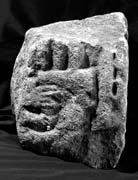Select a site alphabetically from the choices shown in the box below. Alternatively, browse sculptural examples using the Forward/Back buttons.
Chapters for this volume, along with copies of original in-text images, are available here.
Object type: Fragment of cross-shaft [1]
Measurements: H. 34 cm (13.3 in); W. 21.2 > 20.6 cm (8.4 > 8.1 in); D. max. 14.5 cm (5.7 in)
Stone type: Sandstone, pale buff-brown, coarse to very coarse, occasional granule-grade quartz grains, pervasive silica cement, cross-bedded. Carboniferous (Millstone Grit Group) [G.L.]
Plate numbers in printed volume: Ills. 509-11
Corpus volume reference: Vol 8 p. 204
(There may be more views or larger images available for this item. Click on the thumbnail image to view.)
A fragmentary edge survives between the two remaining faces, suggesting this was part of a shaft. The edge has a cabled moulding, now very worn.
A: This shows part of the body of a robed figure holding a book in his right hand, his robe expressed in stylised parallel folds, vertical above the book, curving below.
B: There are elements of a lattice-like background, perhaps part of a scroll, although it could be the spandrel area of a spiral scroll. In the middle next to the left-hand edge is the head of a beast with domed head, snout, ear and lolling tongue, facing left.
C and D: Missing
The figure on face A suggests a stylised version of the busts of saints holding books, as on Otley 1 (Ill. 564), though not as stylised as on Leeds 1 from this site (see above). The inhabited scroll, whatever its type, also links to this tradition, but its angularity suggests a somewhat later date. Collingwood (1915b, 285–8) put this together with Leeds 5, as parts of the same cross.



